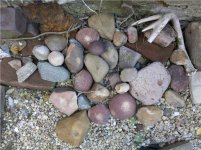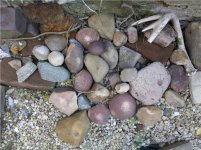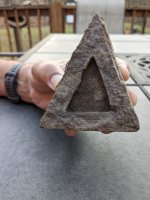You are using an out of date browser. It may not display this or other websites correctly.
You should upgrade or use an alternative browser.
You should upgrade or use an alternative browser.
found on the Ohio river this evening
- Thread starter littlekan
- Start date
O
Ohioan
Guest
Another river find .....Looks like a nutting stone to me although it's possible it could be a paint bowl like the other fella found along the ohio. cool 

O
Ohioan
Guest
He had a premonition 

Get-the-point
Bronze Member
Nice nutting stone!!! The difference between the two is the clear evidence of impact chips off the nutting stone verse the paint pot which has none. That is the difference between the two...........Nice find...........................GTP
ohio
Bronze Member
- May 28, 2007
- 1,039
- 21
Yup definitely a pitstone. I find them all the time on the river. Here is a pic to some of mine as well as a link to a previous, relevant thread...
http://forum.treasurenet.com/index.php/topic,325322.0.html
Chuck
http://forum.treasurenet.com/index.php/topic,325322.0.html
Chuck
Attachments
The Grim Reaper
Gold Member
Get-the-point said:Nice nutting stone!!! The difference between the two is the clear evidence of impact chips off the nutting stone verse the paint pot which has none. That is the difference between the two...........Nice find...........................GTP
The difference in the two is that one show obvious work on the corners and the indentions, while the other one shows no discernable work whatsoever. This one is no doubt a Pitted Stone. The other is more than likely a natural stone that may or may not have been used, but since it was found on the river and not a site it's hard to say whether or not it actually is anything at all.
Get-the-point
Bronze Member
SRV said:Get-the-point said:Nice nutting stone!!! The difference between the two is the clear evidence of impact chips off the nutting stone verse the paint pot which has none. That is the difference between the two...........Nice find...........................GTP
The difference in the two is that one show obvious work on the corners and the indentions, while the other one shows no discernable work whatsoever. This one is no doubt a Pitted Stone. The other is more than likely a natural stone that may or may not have been used, but since it was found on the river and not a site it's hard to say whether or not it actually is anything at all.
OOPS now we have our first disagreement there SRV!!!.......lol..................take notes now!!!
 A pitted nutting stone will show visible evidence around the impact rim. The chips around the rim are the evidence of impact which is what it took to crack those nuts!! Which in his photo's clearly show. Now a pitted paint pot will show none of these traits as it was typical to grind the red ochre or whatever they used to make paint there-fore leaving the pitting smooth from grinding but with evidence of pecking. Pretty much as smooth as a well worked axehead or celt. I have seen several examples if not hundreds of both. A natural stone would not be pitted like that unless it was in the fire and a chip popped out from a gas or air pocket. Still indicating possible usage by Native Americans. Unless it was in a forest fire or under a water drip. The water drip would leave a a-typical hole not being perfectly round but extremely smooth with no clear evidence on it of pecking. I hope I have enlightened you on both. If not I welcome anyone to disagree with this knowledge I have learned through time and schooling. Another thing what is a pitted stone and where did you guys in Ohio get that name for a nutting stone?
A pitted nutting stone will show visible evidence around the impact rim. The chips around the rim are the evidence of impact which is what it took to crack those nuts!! Which in his photo's clearly show. Now a pitted paint pot will show none of these traits as it was typical to grind the red ochre or whatever they used to make paint there-fore leaving the pitting smooth from grinding but with evidence of pecking. Pretty much as smooth as a well worked axehead or celt. I have seen several examples if not hundreds of both. A natural stone would not be pitted like that unless it was in the fire and a chip popped out from a gas or air pocket. Still indicating possible usage by Native Americans. Unless it was in a forest fire or under a water drip. The water drip would leave a a-typical hole not being perfectly round but extremely smooth with no clear evidence on it of pecking. I hope I have enlightened you on both. If not I welcome anyone to disagree with this knowledge I have learned through time and schooling. Another thing what is a pitted stone and where did you guys in Ohio get that name for a nutting stone? The nutting stone had one usage to crack nuts. A Hammerstones use was to smash and pulverize things, along with its use as a weapon, a adze, celt, chisel and axe were used for woodworking and chopping, knives to skin, gut, and flesh skins, bannerstones or Atl-atl used as a weight to propel spears faster with force, etc., etc. Every tool that the Indians used had its own use. I have never heard a "Nutting Stone" called a "Pitted Stone" sounds pretty generic to me and leaves the laymen clueless as to its use! We are here to learn, educate, and provide the proper terminology for all users to learn. So please use proper terminology so those less experienced can learn accordingly........................................Thanks ......................GTP......
Get-the-point
Bronze Member
P.S. I am by no way an expert but I draw from over 23yrs of collecting, reading, schooling, and I have seen so many mistakes and it has to end somewhere and sometime. I think we can all learn from this forum and provide the correct educated terminology. I stated this in another post about point types and how in different parts of the country they are called different names with different sub-types and families, Yet in another part of the country there is a different name for the same style point. It makes no sense other than the fact that the person who found it decided to name it from the place it was found or county or person that found it. To much confusion when they are clearly identical with maybe a slight variation indicating either progression in style or beginning of style. I think this stuff should be clearly noted to really educate instead of seeing the same piece named differently in another state.
The Grim Reaper
Gold Member
Well, I draw from 45 years of collecting and studying Indian artifacts, and though I still don't consider myself and expert, I could take you to numerous spots along the Ohio River where stones identical to the one you called a Paint Pot can be found with identical round depressions in them. They show no work ever done to them by man and are just made by natural erosion. The ones is this post are obviously worked and are Pitted Stones. The term "Nutting Stone" was given to them because people speculated that was what they were used for and they may have been used for just that, but they also could have been used to crush Red Ochre which would make them a Paint Pot. If something like the one in the other post was found on a known Village site them maybe, and just maybe, it was actually used as something and it may have also been a Capstone for a Bow Drill. But coming from the banks of the Ohio River I still say it's a natural rock.
Get-the-point
Bronze Member
I agree with your analysis on certain natural aspects. Due only to the fact that I have seen quite a few natural formations like a root around a stone would make that stone look 4/4 grooved but in essence it is not. I have also stated in the previous comment that natural water formations will be pitted but with a A-typical pit. These two artifacts were clearly worked. That paint pot was clearly worked. The terminology was basically what I was trying to get across. Before they called them nutting stones according to you is when they called them pitted stones. Well this is what I was talking about. If the name has been changed due to new evidence then it should be stated for future learners. That was my main point other than the evidence that I have noticed on those pieces above.
Now if it was a natural stone made like that through time with water dripping on it, it would be smooth with no evidence of pecking. I would not think twice about saying it is such. Since that is not the case with these two pieces evidence suggests that they are nutting stones. Regardless if there was a site above the river bank.
Now if it was a natural stone made like that through time with water dripping on it, it would be smooth with no evidence of pecking. I would not think twice about saying it is such. Since that is not the case with these two pieces evidence suggests that they are nutting stones. Regardless if there was a site above the river bank.
The Grim Reaper
Gold Member
I guess we'll have to agree to disagree. I can see the obvious work on the two Pitted Stones on this post, but the one is this picture has no discernable peck marks on it anywhere and I still say natural.

P
pickaway
Guest
SRV said:I guess we'll have to agree to disagree. I can see the obvious work on the two Pitted Stones on this post, but the one is this picture has no discernable peck marks on it anywhere and I still say natural.

I agree, there was a guy used to post here had hundreds from a river that were natural,you might be able to search older posts to see em...
catherine1
Bronze Member
- Jun 25, 2010
- 1,813
- 1,077
- Primary Interest:
- All Treasure Hunting
These natural rocks could have very well been godsends to the native american indians. I bet they were using them as well as they ones they made.
Captain Al
Jr. Member
Sorry, but I don't understand the root/stone scenario. Are you saying that a root wrapped around a stone would result in a grooved stone. It would seem that for that to occur, the stone would have to grow, and I don't think that happens.Get-the-point said:I agree with your analysis on certain natural aspects. Due only to the fact that I have seen quite a few natural formations like a root around a stone would make that stone look 4/4 grooved but in essence it is not.
Top Member Reactions
-
 2605
2605 -
 1156
1156 -
 1047
1047 -
 892
892 -
 874
874 -
 848
848 -
 787
787 -
 675
675 -
 659
659 -
 642
642 -
 494
494 -
 472
472 -
 467
467 -
 465
465 -
 459
459 -
 432
432 -
 415
415 -
 408
408 -
O
401
-
 389
389
Users who are viewing this thread
Total: 2 (members: 0, guests: 2)
 ? thanks!!!!
? thanks!!!!

![500_00545792[1].jpg](/data/attachments/431/431316-c05b84b4eb5bb24422a7e287f7cd77e4.jpg)
![100_00545795[1].jpg](/data/attachments/431/431353-9d8021d9960c5bbd3b3e64ec2001e88c.jpg)
![500_00545793[1].jpg](/data/attachments/431/431358-652ca5d217a7825f3963c68730bcdd46.jpg)
![500_00545794[1].jpg](/data/attachments/431/431362-a46564c453146c8c6578405b5f44c18a.jpg)
 The other fella headhunter7 is my buddy who was about 20 miles up the river tonite. If he woulda answered his phone i would have found that drill and painters pot
The other fella headhunter7 is my buddy who was about 20 miles up the river tonite. If he woulda answered his phone i would have found that drill and painters pot 


